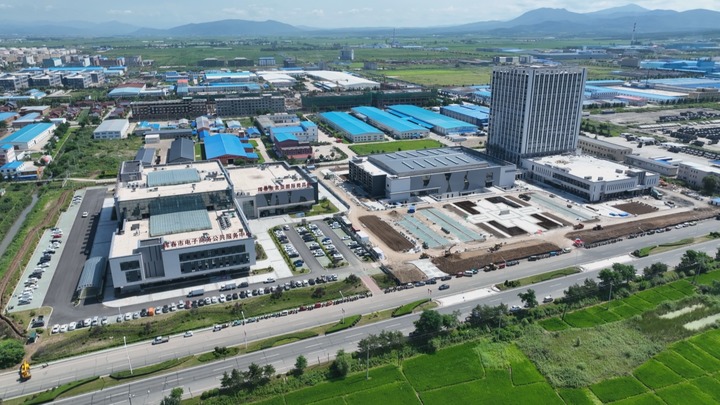
This aerial photo taken in 2022 shows the integrated pilot zone for cross-border e-commerce in Hunchun, northeast China's Jilin province.(Xinhua/Jin Jinxiu)
BEIJING, Aug. 3 (Xinhua) -- Cross-border e-commerce has injected new power into the high-quality development of China's foreign trade due to its fast development, large market potential, and strong driving effect.
In the first half this year, cross-border e-commerce maintained sound momentum which effectively facilitated scale stabilization and structure optimization of the country's foreign trade.
Cross-border e-commerce is expected to have brighter prospect for development with trade enterprises’ efforts and policy assistance, analysts say.
Rapid development
China's cross-border e-commerce has developed rapidly in recent years, becoming a new engine for the high-quality development of foreign trade. Customs data shows that imports and exports of China's cross-border e-commerce reached 2.1 trillion yuan in 2022, an increase of 7.1 percent year on year and accounting for 4.9 percent of the total trade of goods.
In the first half of this year, China's foreign trade showcased strong resilience, exceeding 20 trillion yuan amid complex external environment. During the same period, the imports and exports of China's cross-border e-commerce amounted to 1.1 trillion yuan, a year-on-year increase of 16 percent. Specifically, exports amounted to 821 billion yuan, an increase of 19.9 percent, while imports stood at 276 billion yuan, an increase of 5.7 percent.
“We are constantly exploring new markets and channels”, said Wang Yongyu, sales director of Jiangsu Huajia Silk Corp., Ltd, a company based in Wujiang District, Suzhou, Jiangsu Province.
“We applied big data to analyze market demand for order optimization, and cross-border e-commerce helps us to achieve flexible manufacturing that being able to cover a broader market with less costs”, Wang said, noting that the company started cross-border e-commerce B2B (business to business) export business last August, and the company's total exports through cross-border e-commerce had already exceeded 20 million yuan in the first half of this year.
Thanks to the developement of cross-border e-commerce, Wujiang District has seen more and more of its silk products sold to overseas markets. It is noted that there are currently some 160 registered cross-border e-commerce companies in Wujiang District.
Statistics by Wujiang Customs show that Wujiang's exports of silk products reached 234 million yuan in the first half of this year, a year-on-year increase of 56.4 percent.
China’s cross-border e-commerce has developed rapidly in recent years. Data by the Ministry of Commerce (MOC) shows that the proportion of trade through cross-border e-commerce in the country's total foreign trade has increased from less than 1 percent five years ago to around 5 percent by now.
“Cross border e-commerce is changing from a new business format to a new normal of foreign trade”, according to Zhao Ping, president of the Academy of China Council for the Promotion of International Trade (CCPIT).
Going global
The development of cross-border e-commerce has further improved supporting facilities such as overseas warehouses.
“Traditional foreign trade is about waiting for orders to come so that our bargaining power is relatively weak, but cross-border e-commerce provides new channels and opportunities for our brands to go overseas”, said Yu Jiaqi, head of customs affairs with Suncha Technology Co., Ltd. in Yuhang District, Hangzhou, east China's Zhejiang Province.
“Our products, mainly bamboo chopsticks, chopping boards, etc., have always been sold to major overseas stores. Now, we begin to expand the market and increase investment in e-commerce platforms”, Yu said, noting that the company is steadily promoting overseas warehouse business for exporting through cross-border e-commerce.
Overseas warehouses have become important channels and growth drivers for cross-border e-commerce enterprises due to their flexible management advantages of early stocking, bulk transportation, and local returns and replacement. “Now, after foreign consumers place orders on the platform, we can ship directly from overseas warehouses to provide a better shopping experience and help improve reputation and popularity”, Yu said.
It is learned that Hangzhou Customs has completed the registration of 415 overseas warehouse enterprises for cross-border e-commerce exports.
Rolling-out support
Driven by policies such as the integrated pilot zones, ecosystem of China's cross-border e-commerce is constantly improving. Data shows that there are over 100,000 cross-border e-commerce entities in China, over 200,000 e-commerce websites, and about 690 cross-border e-commerce industrial parks in the integrated pilot zones, signing bilateral e-commerce cooperation memorandums with 29 countries.
Other supporting measures are gradually in place as well. "Cross-border e-commerce plus industrial belt" will be developed to facilitate more local specialties to enter global markets based on existing 165 integrated cross-border e-commerce pilot zones in combination with the industrial endowments and geographical advantages of various regions, according to the MOC.
Meanwhile, measures will be taken to help cross-border e-commerce integrated pilot zones further optimize service platform functions, guide overseas warehouse enterprises to better connect to online service platform, and strive to integrate customs clearance, taxation, finance, and overseas warehousing functions to achieve one-stop comprehensive services.
Locally, plans are rolling out as well to promote the high-quality development of cross-border e-commerce. For example, Shanghai has recently issued the Action Plan of Shanghai Municipality on the Promotion of the High-Quality Development of Cross-border E-Commerce (2023-2025) to put forward 18 key tasks such as continuously promoting the construction of cross-border e-commerce demonstration parks, implementing the “Quality Product Export” action plan, and improve the level of cross-border e-commerce public services. Shandong proposed to create 20 cross-border e-commerce characteristic industrial belts in the province by 2025, cultivate 100 well-known cross-border e-commerce brands with strong international competitiveness, and incubate 1,000 emerging cross-border e-commerce enterprises.
But the fast-growing cross-border e-commerce also faces challenges. Some experts believe that localization is a major challenge faced by many cross-border e-commerce enterprises when going overseas. How to meet local needs, address industry barriers, and comply with regulatory requirements require enterprises to base themselves on the comprehensive situation of overseas markets, efficiently organize international supply chains, and provide better services and products, they say. (Edited by Niu Huizhe with Xinhua Silk Road, niuhuizhe@xinhua.org)




 A single purchase
A single purchase









